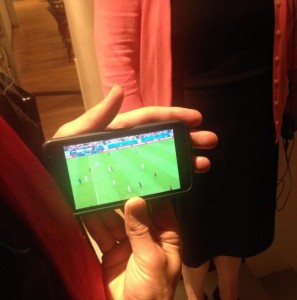It’s the of the Big Game (the Large Challenge, if you’re definitely trying to avoid copyright infringement) and if you’re like me, you’ve been invited to a party but haven’t had a minute this week to think about what you’re bringing. But you don’t want to show up with a box of cookies from a nearby supermarket because then you look like you make poor choices managing life priorities. (Isn’t your friend worth something handmade?)
And to throw another twist into this situation, the host of your Super Bowl party is vegan. And so will be a few other attendees.
Well, darn this all to get out. No, don’t darn it all, because guess what? There is a quick solution you can still pull off.
Here are My Big Fat Vegan Super Bowl Cupcakes, adapted from this recipe last year when I had three vegans over to my apartment for the Super Bowl. They have now become my go-to cupcake.
1) Go over to Wegmans, Tops, or one of those Massachusetts grocery stores that continue to make me hang my head in disgust and say, “Boston, you deserve better grocery wise.” Buy Duncan Hines’ Devils Food cake mix. Even better, if you’re at Wegmans, Whole Foods or a store with an organic section, go to the organic baking section and buy the Madhava chocolate cake mix. Pick up cupcake liners (preferably football ones), Earth Balance butter, a jar of organic peanut butter, almond milk (smallest container of it you can find), a can of Whole Foods or Maine Root root beer (or in a pinch, plain old Coca-Cola will work) and head home.
2) Get home. Get out a medium sized mixing bowl, a mixing spoon, your cupcake pan, and your cupcake liners. Drop the cupcake liners in your pan, and preheat the oven to whatever temperature the cake mix box says to.
3) Pour your cake mix into the mixing bowl. Add your can of root beer/Coca-Cola and stir. Voila! Your cake batter.
4) Pour your cake batter into the cupcake liners. When I use the Madhava, it makes 18 big cupcakes. It doesn’t grow as much as regular batter, so keep that in mind as you fill the liners.
5) Bake for the amount of time provided on the cake mix box. Check on them five minutes prior to the finish time – sometimes they’ll bake faster than anticipated.
6) While your cupcakes are baking, whip up the vegan peanut butter frosting. I modified the peanut butter frosting recipe provided on the blog LunchBoxBunch. I use 1/3 cup organic creamy peanut butter, 1/3 cup Earth Balance, three drops vanilla extract, three tablespoons almond milk, and 1/2 cup powdered sugar. Mix it together and let it sit in your fridge until the cupcakes are done baking and cool.
7) Once your cupcakes are finished baking, out of the oven and cooled, frost them with the peanut butter frosting. Is it going to be as pretty as your fad-influenced local cupcake shop (who is probably closing its doors and becoming a juice bar as we speak, because that’s what is happening to all the ones in Boston)? No. Is it going to taste good? Yes. So suck it up that you aren’t going to win Cupcake Wars with this and just frost those cupcakes.
There you go. You made vegan chocolate peanut butter cupcakes in less than 45 minutes and can show up to your Super Bowl party looking all thoughtful and such.
